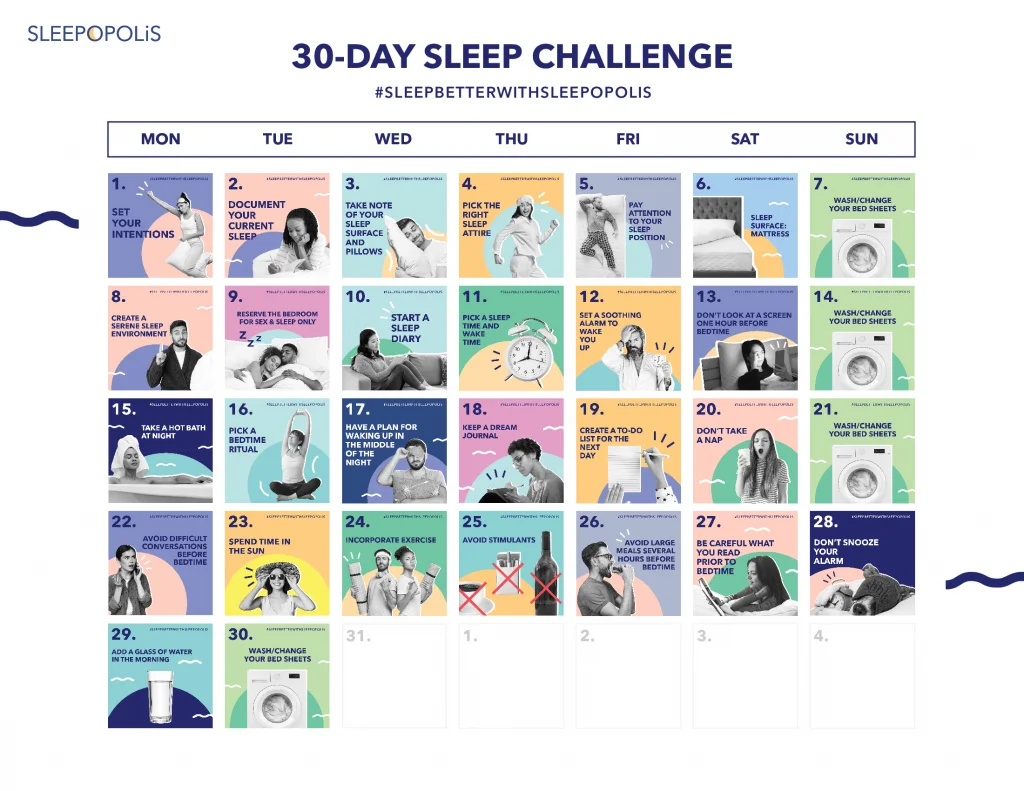 Download your own sleep calendar here!
Download your own sleep calendar here!
Proper sleep hygiene is extremely important if you want to sleep better. Sleep hygiene refers to the set of behaviors and environment related to your sleep habits. The key to better sleep hygiene is commitment and consistency. We suggest creating a plan to achieve that.
We worked with medical experts to put together this general sleep hygiene plan so you can experiment with what does or doesn’t work for you. To see real results, you should commit to a plan and stick with it. If you follow this 30-day sleep plan every day, your new sleep habits may start to come more naturally. You might be surprised by how much your sleep improves by adding these simple adjustments to your routine.
Keep in mind that a sleep hygiene plan typically will not cure chronic insomnia or sleep apnea. It can, however, help you improve your quality of sleep.
Note: These general recommendations should not be taken as medical advice. If you suspect you are suffering from a sleep disorder or another health condition that is affecting your sleep, consult your physician or a trained medical professional.
Week 1
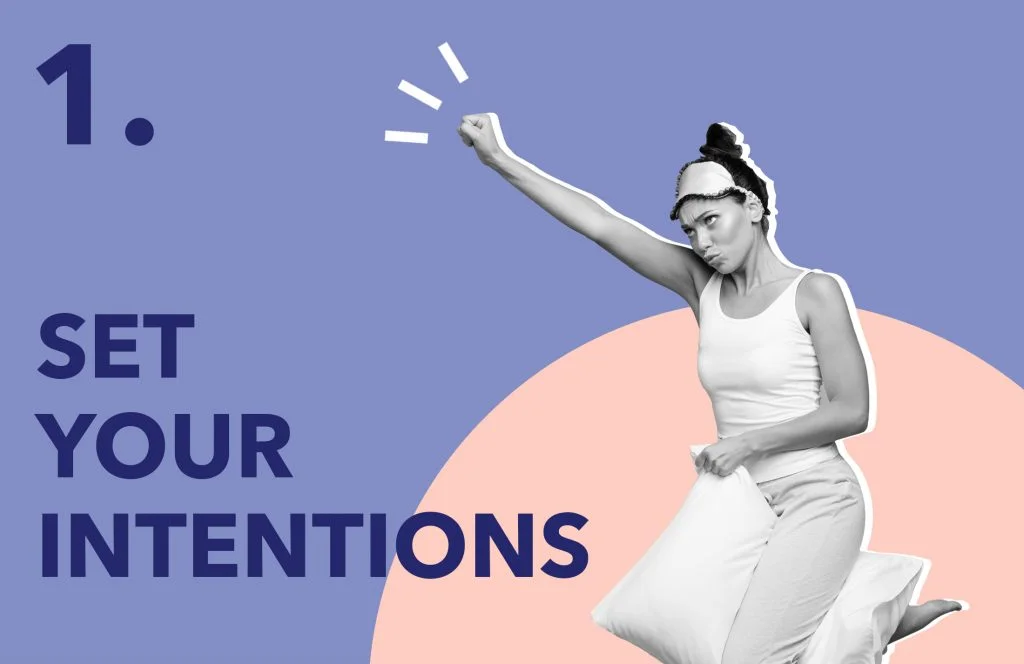
Day 1: Visualize and commit to your sleep plan: set your intentions.
Improving sleep is a process that takes time and requires long-term commitment, but you can do it! Before you begin, you could journal your personal goals so that you know what you want to get out of this sleep plan. Hopefully the healthy sleep practices you learn from this 30-day plan can carry on with you for the rest of your life. Who knows? Maybe you’ll add a tip or two to your new nightly routine.
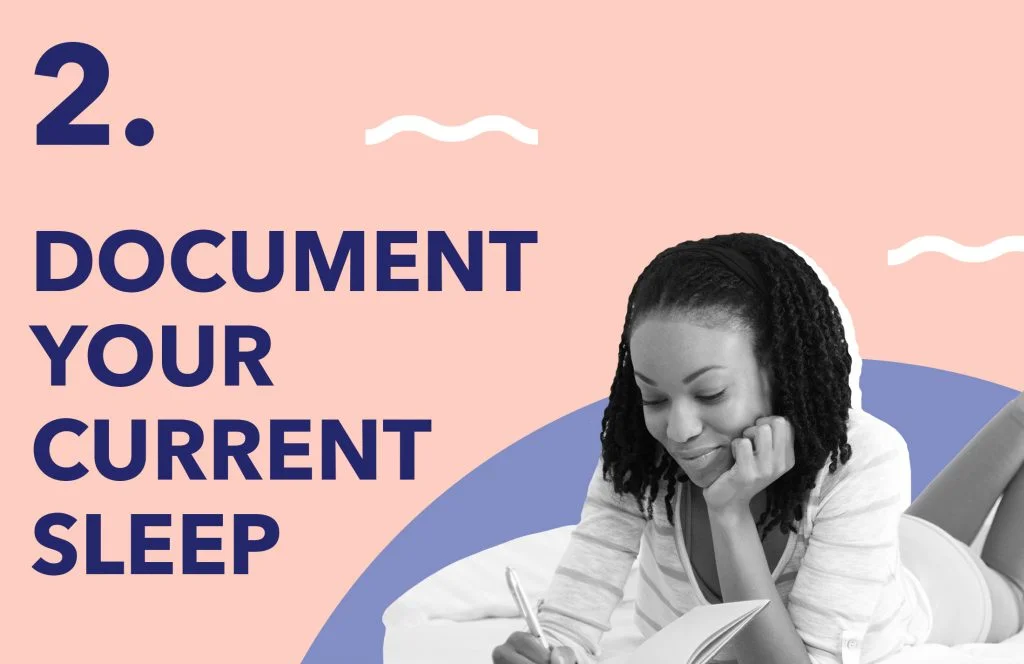
Day 2: Observe and document your current sleep and surrounding behaviors.
Grab something to write on and observe what your current habits are and the areas that need improvement. This is about making an initial assessment of your current sleep behavior. You’ll only write this once. Later, we’ll look into creating a detailed sleep diary, which you’ll write in each night.
For your initial, one-time assessment, take note of things like:
- What is your daily schedule like? Do you exercise in the morning? In the afternoon? What time do you wake up in the morning? What time do you go to sleep at night?
- Do you have a bedtime routine with detailed steps? Make a timeline of your current sleep routine. For instance:
- 8pm: Skincare
- 8:30pm: Meditation
- 9:30pm: No more screen time
- 10pm: Read a book
- 10:30pm: Lights out
- How do you sleep through the night? What is your sleep position? Do you wake up easily or often at night? Do you sweat at night? Do you use a night light? Do you dream?
- Do you consume caffeine throughout the day? What foods do you eat before bedtime? How long before sleeping do you eat? Do you get hungry late at night? If so, do you eat a snack? What is your snack? Do you drink alcohol to help you sleep?
Put your assessment near your bed and review it as needed.
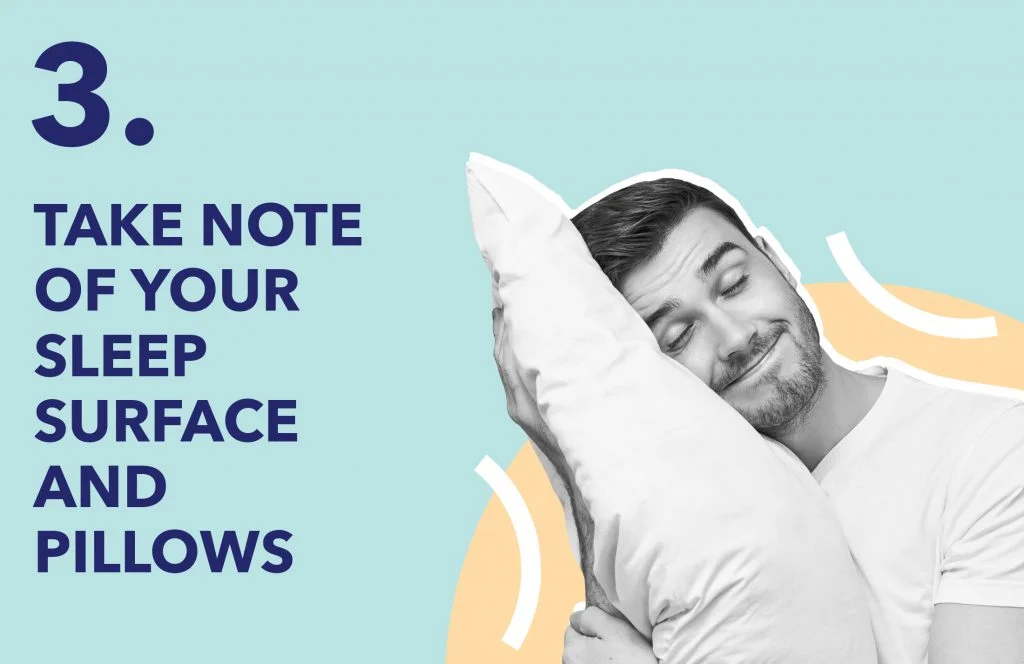
Day 3: Take note of your sleep surface and pillows.
If you are a hot sleeper, consider shelling out some cash for quality, cooling sheets. If you are a cold sleeper, get some warmer sheets. If you suffer from allergies, you can upgrade to hypoallergenic sheets.
Additionally, you’ll want to choose the right pillow to match your preferences. Consider placing pillows under your stomach (if you’re a stomach sleeper), under your legs (if you’re a back sleeper), or in between your knees (if you’re a side sleeper). These small changes will help you rest better as your body relieves pressure in the right places and improves spinal alignment.
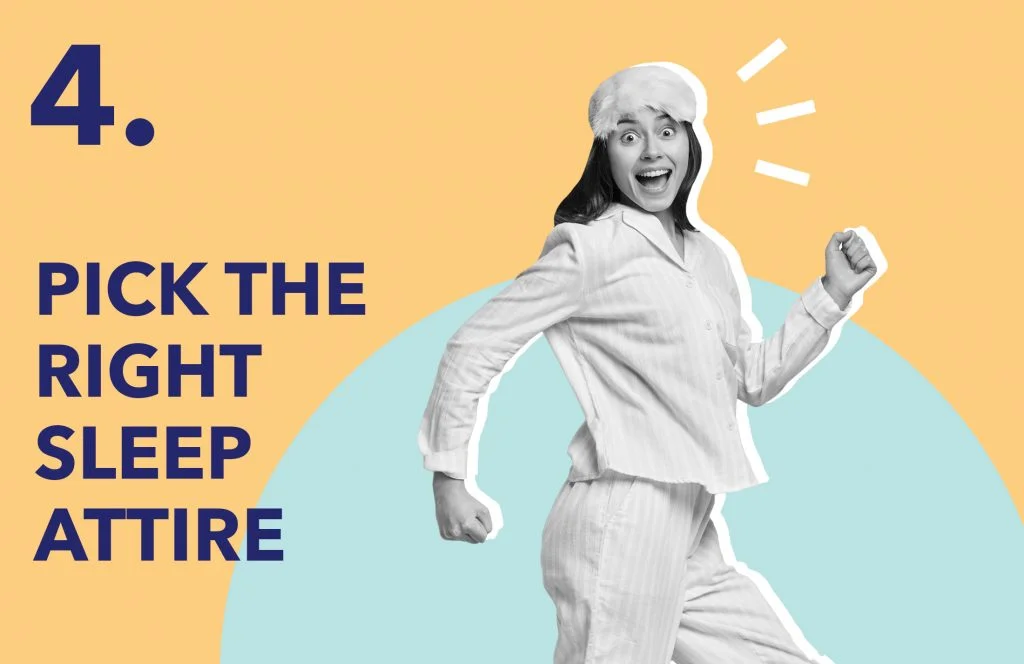
Day 4: Pick the right sleep attire for you.
This can include breathable, loose fabrics, such as a large comfortable shirt. Dr. Samantha Gaies of NY Health Hypnosis & Integrative Therapy recommends wearing fewer or even no clothes to allow the body to regulate its own temperature. This is not one-size-fits-all — you should pick the clothing, or lack thereof, that suits your comfort preference. The most important thing here is your comfort!
Day 5: Pay attention to your sleep position and adjust as needed.
If you experience aches and pain at night, you’ll want to be sure you sleep in the right position. Sleeping in the wrong position will only exacerbate your pain. Here a few things to consider as you pick a position:
- There isn’t one “optimal” position: Your size, weight, shape, and changing personal preferences are all factors that will determine the best position for you.
- Keep your spine, hips, and shoulders aligned: Proper posture is one way to prevent pain.
- Experiment with different positions: Try sleeping on your side one night and switching to your back the next. Then choose the one that feels best.
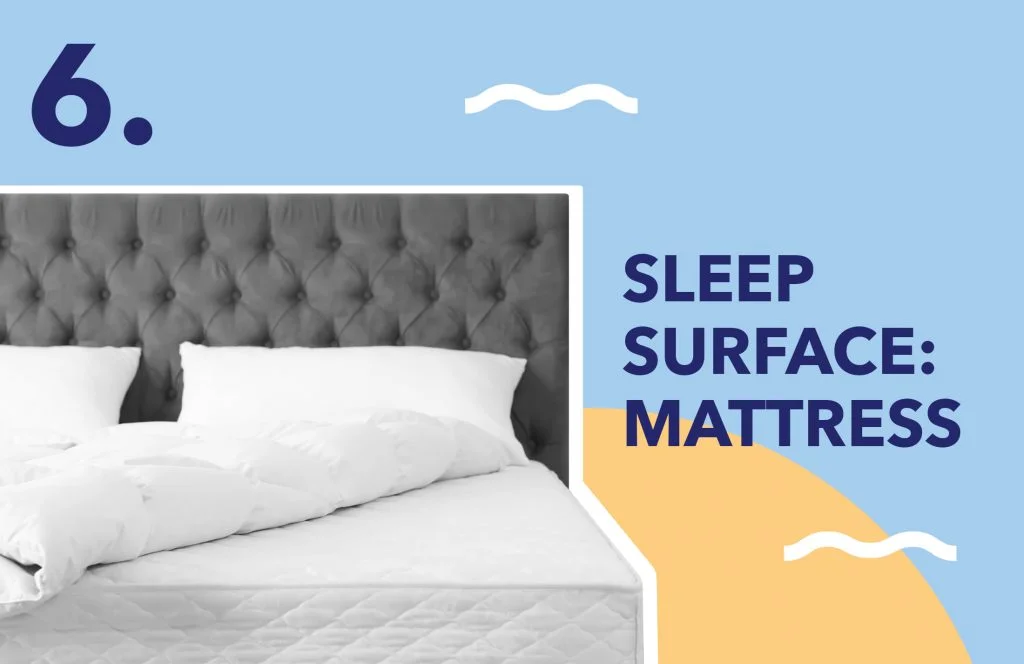
Day 6: Sleep surface: mattress.
The right mattress should keep your head, neck, and spine all in neutral alignment. Choosing the best mattress for you is incredibly important for improving sleep (but you probably already know that). You’ll want to make sure it provides enough support and tension relief to suit your firmness and position preferences, so you can sleep like a baby. Dedicate this day to conducting some mattress research and figuring out which mattress will be most beneficial for you. If you need a place to start, give our mattress quiz a try.
Day 7: Wash/change your bed sheets.
Your bed sheets should be washed and changed once a week. This will help reduce the number of dust mites in your bed, allergens, and bacteria that collect on your sheets. Cut back on the irritants to get better shut-eye.
Week 2

Day 8: Create a serene sleep environment.
The importance of your sleep environment cannot be overstated. You want to create a relaxing, dark environment to promote better sleep. Some ways you can optimize your sleep environment are:
- Setting a cool, comfortable temperature
- Use a white sound machine if there’s noise that’s impacting your sleep
- Use air purifiers to reduce allergens and improve air flow
- Use a dehumidifier or a humidifier, depending on whether your humidity is high or low
- Put up blackout curtains
- Use an aromatherapy diffuser
These are just a few suggestions, so feel free to try out something that’s not in this list!
Day 9: Reserve the bedroom for sex and sleep only (1).
This sets your bedroom up as a place where your brain, specifically the hypothalamus, sends signals to calm you down and help you unwind. One way to cut back on your time spent in the bedroom is to remove your TV, so you’re not tempted to use it as a place where you eat popcorn and watch movies. You could also remove any work area you’ve set up and move your home office out of your room. Establishing your bedroom as a place that is (mostly) reserved for sleep allows you to calm arousal before the chemical kicks in and reduces your arousal further. (2)
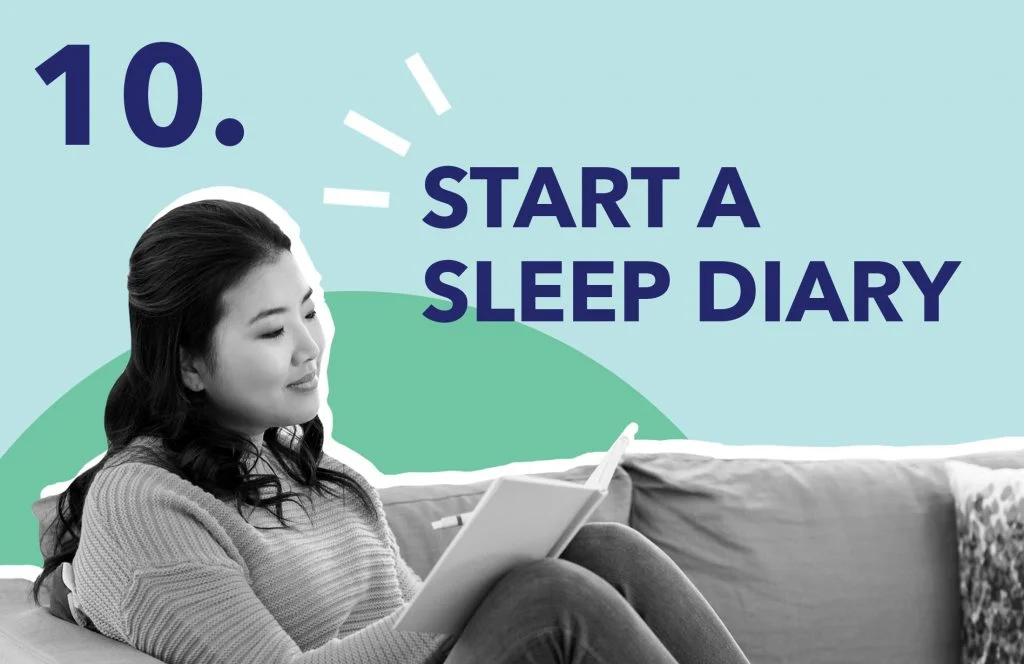
Day 10: Start a sleep diary.
Congratulations, you now know how you sleep! Now it’s time to begin to habitually record your sleep behaviors. Here is an example of one from Dr. Shelby Harris, a board-certified behavioral sleep medicine expert and author of The Women’s Guide to Overcoming Insomnia: Get a Good Night’s Sleep without Relying on Medication:
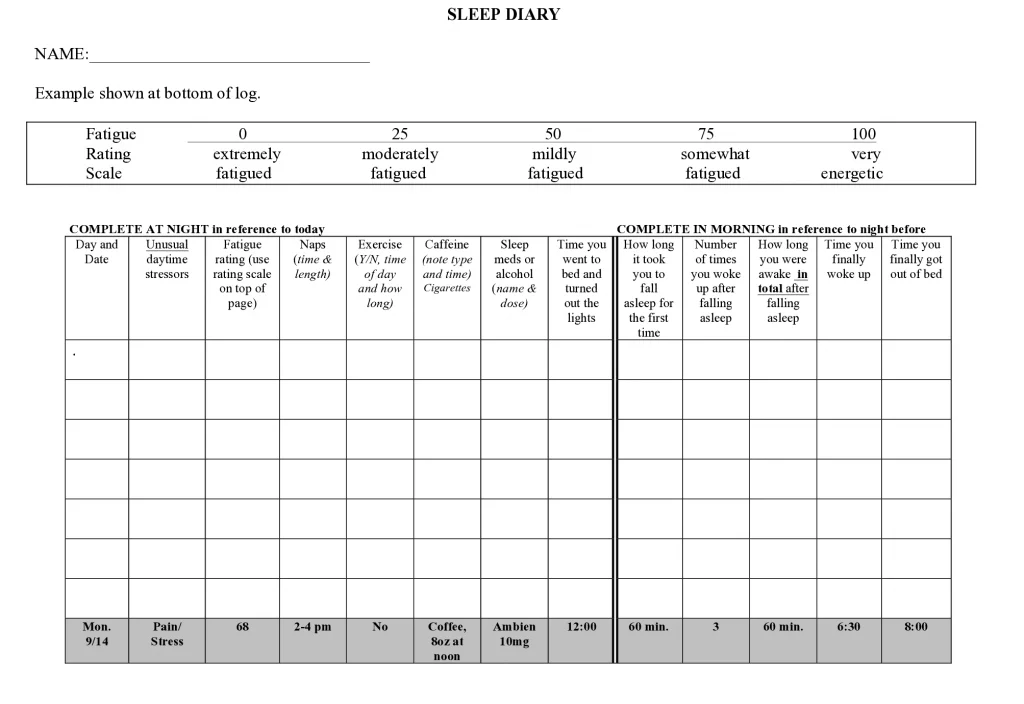
The items you list here should be more specific than what you noted in Day 2. Day 2 is “setting the scene” in terms of observations, and these should be more specific to help you target specific sleep problems. A downloadable copy and instructions for keeping this sleep diary can be found here on Dr. Harris’ website.
Day 11: Pick a sleep time and wake time to follow every day of this plan.
We know this will likely be difficult for folks who like to sleep in until noon on the weekends, but this will be worth it. After analyzing your current behaviors, you should start performing repeated behaviors to begin forming habits. All this starts with a fixed sleep schedule.
The recommended amount of sleep for most people is seven to eight hours. Dr. Harris says that although most folks do best with this amount of sleep, some are outliers who only need around six hours, while others need as much as nine hours. Dr. Gaies says it’s important to stick to this schedule on the weekends. She says using the weekend as an excuse to wake up several hours after you normally would during the week can cause a jet lagged feeling. If you want to sleep in a little, she recommends no more than one hour after your normal wakeup time.

Day 12: Set a soothing alarm to wake you up.
Loud/aggressive tones (or heavy metal music) to wake up to can cause stress. Going from a state of unconsciousness (sleep) to wakefulness is a process, make it a smooth one with a soothing alarm tone.
Day 13: Don’t look at a screen one hour before bedtime. (3)
This includes checking your phone, watching TV, or reading from a tablet. Dr. Gaies notes that cutting blue light at least an hour before bed signals to your brain that it’s time to sleep. If you use a blue light right before bed, she says it may cause problems with your circadian rhythm. So try to resist the urge to check Facebook right before bed.
Day 14: Wash/change your bed sheets.
Pull out the detergent because it’s time to wash your bedsheets again!
Week 3
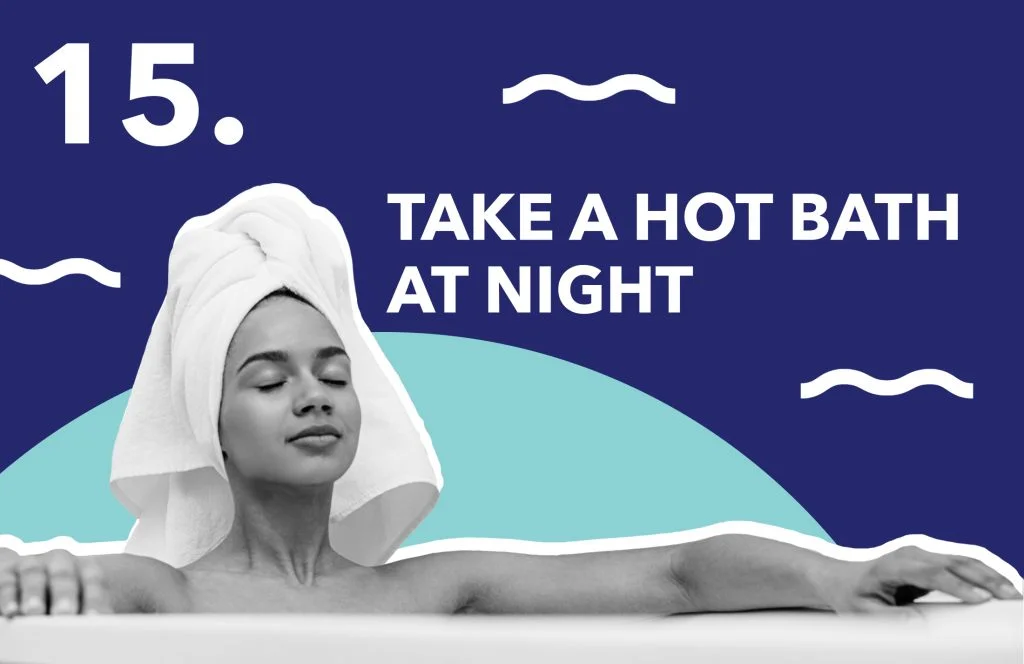
Day 15: Take a hot bath at night.
Finally, you have an excuse to pull out all the bath bombs you were gifted from family members over the holidays! Dim the lights, safely light some candles, and soak in the suds an hour and a half to two hours before bedtime to help you relax. Dr. Harris recommends taking a hot bath an hour and a half to two hours before bedtime to help sleep onset.
Day 16: Pick a bedtime ritual, ideally outside of your bed.
Some of the ways you can do this include practicing gentle yoga (4), reading a physical book, meditating, or practicing deep breathing (5). Dr. Gaies also recommends adult coloring books and puzzles. So get out some colored pencils and get ready to relax!
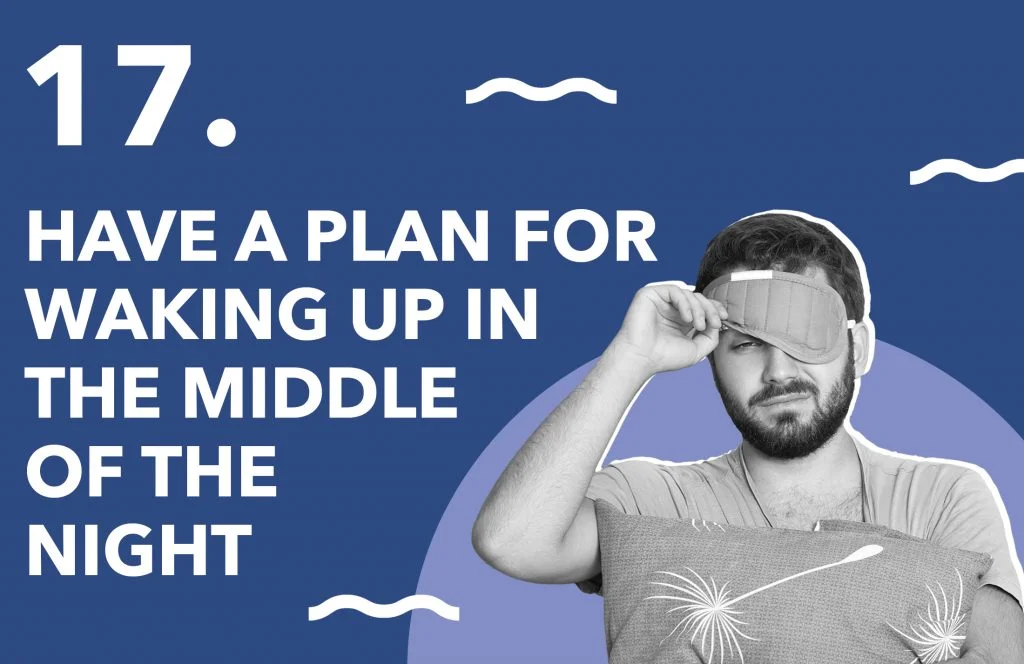
Day 17: Have a plan for waking up in the middle of the night.
Do you have trouble falling back asleep if you wake up at night? Put a plan in place. For instance, Dr. Gaies recommends not staying in bed more than approximately 15 to 20 minutes, just guesstimate without clock watching. She says that any more can begin to form a negative association in your mind between your bed and not sleeping. If you do get up, Dr. Harris says to go to a quiet space with dim lighting and without screens. She says to return to bed once you’re feeling sleepy and to be sure not to fall asleep on the couch.
Day 18: Observe your dreams: keep a dream journal.
This shouldn’t include your hopes and dreams about where you want to go in life. Dr. Harris says, “if you’re having routine nightmares or upsetting dreams, consider talking with a sleep doctor about other interventions as there are very useful treatments for nightmares.” She also notes that consistent vivid dreaming may be related to sleep apnea or melatonin use and other sleep medications.
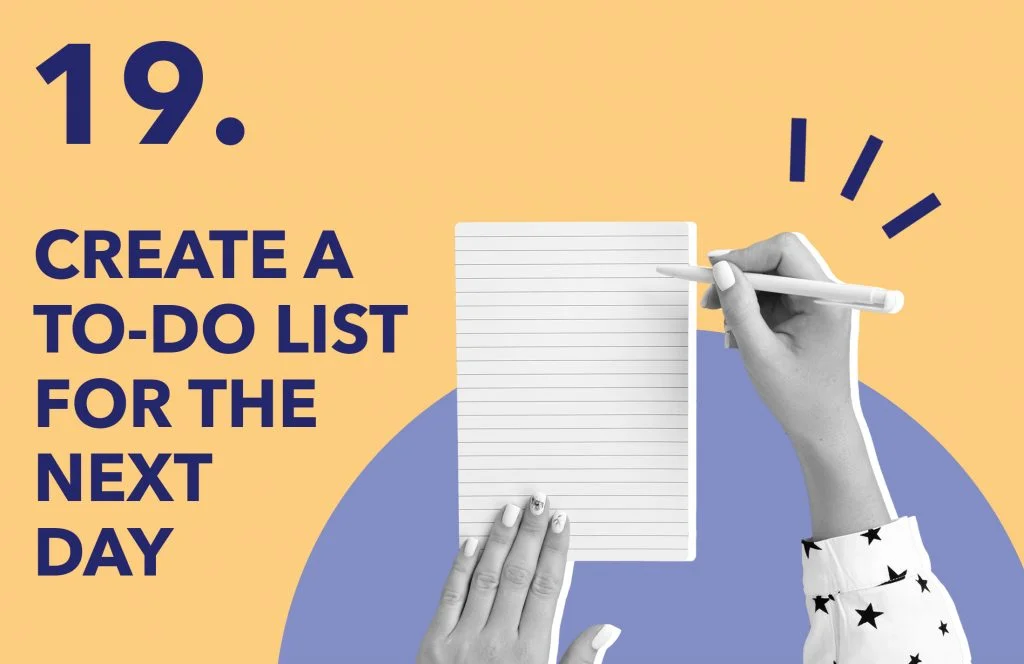
Day 19: Create a to-do list for the next day.
Thinking of what we need to do the next day can stress us out. Since stress activates the defense system of the central nervous system, this kind of thinking can lead to insomnia. (6) So set time aside a few hours before bedtime to create a to-do list and spare yourself from this avoidable stressor.
Day 20: Don’t take a nap.
We’ve all hit that afternoon slump in the middle of the work-day and felt the tempting pull of a quick nap to reset the day, but napping during the day can actually harm your night-time sleep and cause a nasty disruption to your sleep cycle. (7) When you feel your eyelids drooping throughout the day, try to get up and be active for a few minutes. Getting your heartbeat pumping by doing some jumping jacks, walking your dog, or having a mini-dance party can be more effective than a nap or that third cup of coffee.
We know that some schedules/people require napping, so if you must, do it for only 20 minutes. (8) Dr. Harris says it’s best to nap before 2pm and in your own bed. In addition, she says that if you regularly need a nap to function throughout the day, you should talk to your doctor.
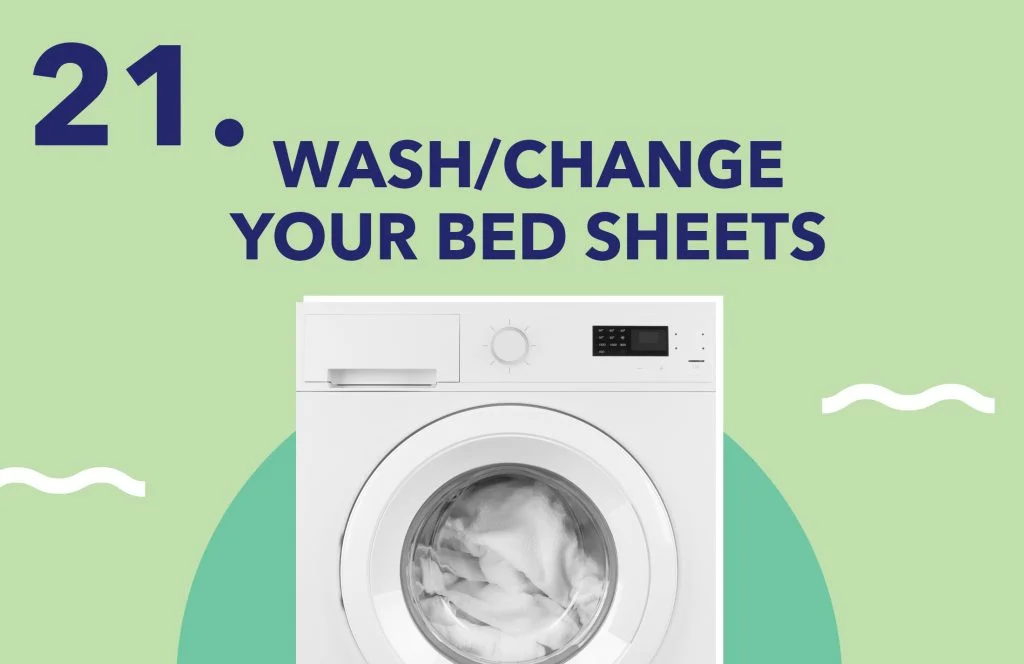
Day 21: Wash/change your sheets.
If you’re getting bored from changing your bed sheets more often than you’re used to, try listening to music while you make your bed and make it a dance party!
Week 4
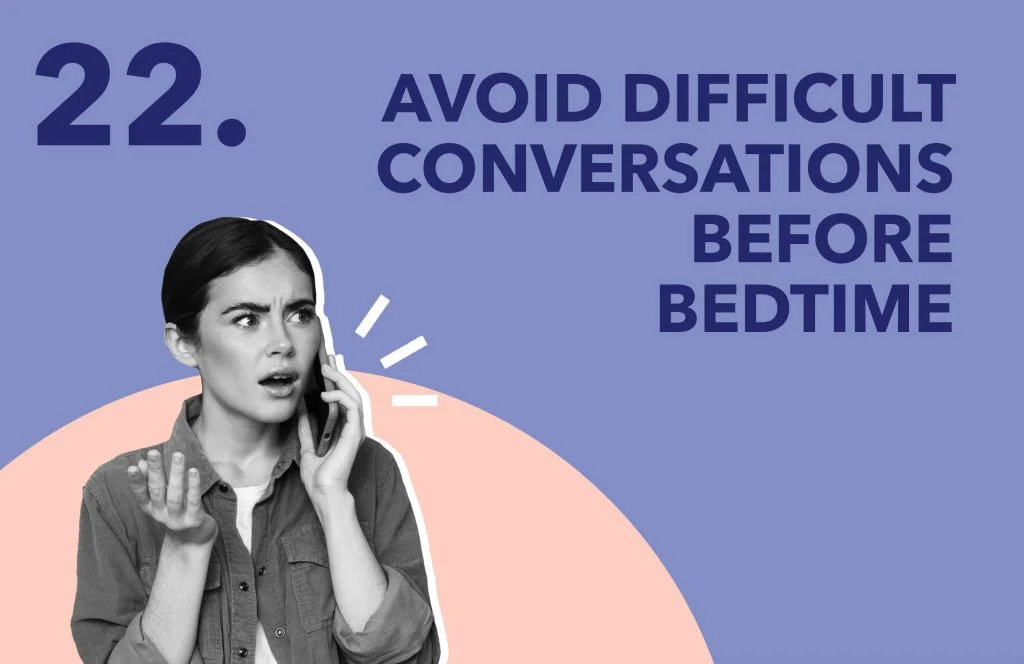
Day 22: Avoid difficult conversations before bedtime.
Tense conversations can lead to increased stress, which won’t help you sleep. According to a 2020 study in the Journal of Family and Community Medicine, which examined 230 adults, stress was a major contributor to poor sleep quality. (9) To improve your chances for having quality sleep, try to set an intention with your bedmate to only have lighter, more casual conversations before bed, such as discussing your favorite movie or TV show.

Day 23: Spend time in the sun.
Pause the TV show you’re binging and get some fresh air! Spending time in the sun gives our bodies vitamin D. A lack of vitamin D can negatively impact sleep. According to a 2018 study in Nutrients, without enough vitamin D, we could be susceptible to sleep issues. (10)
Harvard Health Publishing says there are various factors to consider when determining how much time you should spend in the sun each day. These include where you live, the time of day, and the season, among others. As a general rule, they recommend getting 10 to 15 minutes of sunlight multiple days a week. This should give your body enough Vitamin D. (11)
Day 24: Incorporate exercise into your day routine.
Ever wanted to try a new sport? There’s no time like the present! Research shows that exercise can help reduce the severity of sleep issues, such as sleep apnea, and improve your sleep quality. (12) According to the CDC, you should exercise at least 150 minutes a week (13) at least three hours before bedtime. (14) You can break this up however you’d like, such as 30 minutes a day for five days or 50 minutes a day for three days. Avoid exercise within 3 hours of bedtime. If you get the chance, try to get a brisk 20-minute session in about 4-6 hours before your routine bedtime as that can help some people with falling asleep.
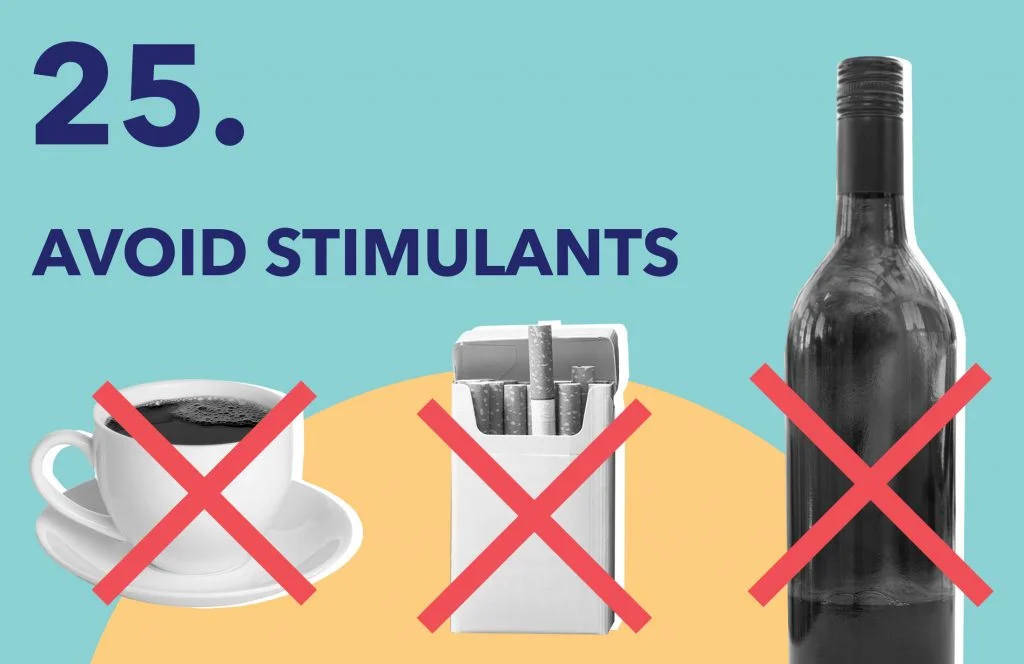
Day 25: Avoid stimulants like nicotine, caffeine, and alcohol three hours before bed. (15)
Dr. Gaies recommends no caffeine after 3pm, because it can stay in your system, on average, for five hours. She also suggests not drinking alcohol right before bed. She says, “People often think that alcohol helps them fall asleep; however, it only really offers a feeling of drowsiness, and then ultimately interrupts deeper sleep later in the night.” So if you’re tempted to make a late night trip to Starbucks, consider drinking water instead.
Day 26: Avoid large meals several hours before bedtime.
Eating meals at regular times helps balance your sleep-wake rhythm by helping set your biological clock (16). This includes more than meals. Big snacks should also be avoided, so put down that whole pizza before tucking in for the night. If you must eat something, eat only small portions.

Day 27: Be careful what you read prior to bedtime.
Reading an exciting or scary book can cause stress, particularly because it can get your adrenaline flowing. Reading an intense story in the news can cause similar reactions. Since adrenaline causes you to wake up, it’s best to stick with reading material that will help you relax. Maybe you could pull out some of your old college textbooks to help you drift off to sleep.
Day 28: Don’t snooze your alarm in the morning.
The snooze button might seem amazing, but it’s not great for quality sleep. Dr. Harris says that throughout the night, we cycle between deep sleep, light sleep, and rapid eye movement (REM) sleep. She explains that using the snooze alarm disrupts your sleep pattern and the broken sleep you get with each snooze alarm doesn’t allow you to properly go through these cycles in a meaningful, helpful way.
Your alarm disrupts your sleep pattern — whether REM or non-REM. Since these patterns last longer than 5 to 10 minutes, the time you spend sleeping after you hit the snooze button will not result in restorative sleep.
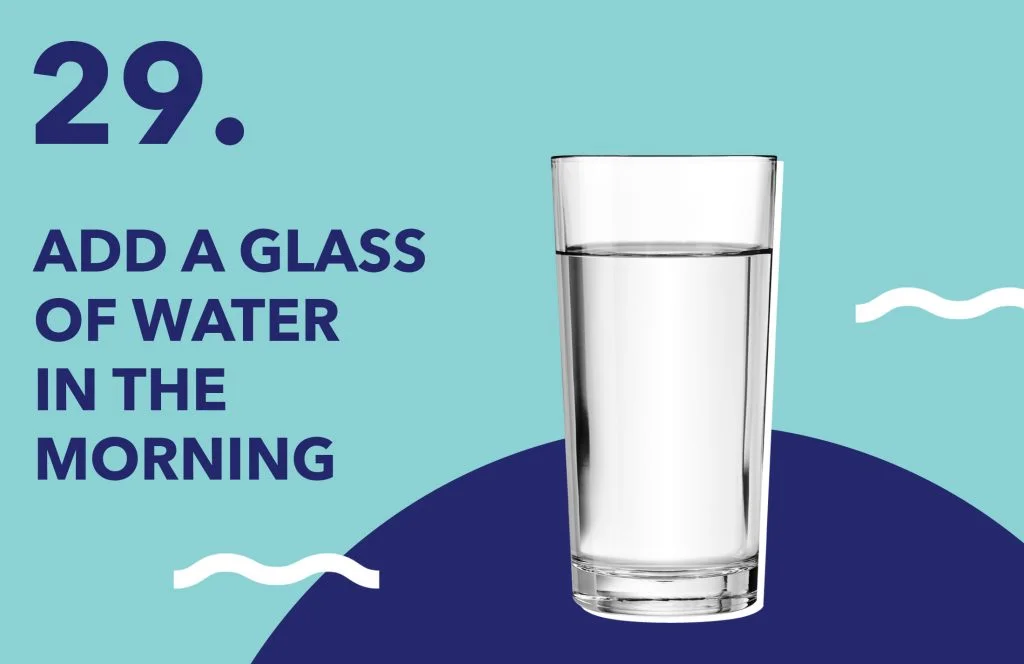
Day 29: Add a glass of water in the morning.
The brain is made up of 73% water (17), so you need to keep it hydrated. Since you should avoid liquids during the nighttime, it’s best to drink water soon after waking up. Place a glass of water near your bedside and drink it first thing in the morning. Or consider drinking water in your favorite coffee mug before you fill it with coffee.
Day 30: Wash/change your sheets.
Get excited, because it’s now time to play another round of “scrub my sheets!” OK, maybe it’s not that exciting, but it is necessary. Plus, you’ll get to feel a cozy, warm feeling if you dry them right before bedtime.
That concludes our 30-day sleep hygiene plan. We hope this plan provides some guidance for better sleep and that you start noticing improvements. Remember: Stay consistent and wash your sheets often. Happy sleep scheduling!
References
- “Regulatory and Fatigue Risk Questions and Answers.” Federal Aviation Administration. https://www.faa.gov/about/initiatives/maintenance_hf/fatigue/faq/
- “Brain Basics: Understanding Sleep.” National Institute of Neurological Disorders and Stroke. https://www.ninds.nih.gov/Disorders/Patient-Caregiver-Education/Understanding-Sleep
- “Blue light has a dark side.” Harvard Medical School. https://www.health.harvard.edu/staying-healthy/blue-light-has-a-dark-side
- National Survey Finds People Use Dietary Supplements and Yoga for Wellness Reasons, Chiropractic for Treating a Condition. https://www.nccih.nih.gov/research/research-results/national-survey-finds-people-use-dietary-supplements-and-yoga-for-wellness-reasons-chiropractic-for-treating-a-condition
- Jerath, R et al. Self-Regulation of Breathing as an Adjunctive Treatment of Insomnia. Frontiers in Psychiatry, Jan 29, 2019.
- Han, K et al. Stress and Sleep Disorder. Experimental Neurobiology. Dec. 26, 2012.
- Troxel, W et al. Clinical Management of Insomnia with Brief Behavioral Treatment (BBTI). Behavioral Sleep Medicine. Oct 2012.
- “Sleep Deprivation and Deficiency.” National Heart, Lung, and Blood Institute. https://www.nhlbi.nih.gov/health-topics/sleep-deprivation-and-deficiency
- Alotaibi, A, et al. The relationship between sleep quality, stress, and academic performance among medical students. Journal of Family and Community Medicine. Jan 13, 2020.
- Gao, Q et al. The Association between Vitamin D Deficiency and Sleep Disorders: A Systematic Review and Meta-Analysis. Nutrients. Oct 2018.
- “Time for more vitamin D.” Harvard Medical School. Sep, 2008. https://www.health.harvard.edu/staying-healthy/time-for-more-vitamin-d
- Kline, C et al. The Effect of Exercise Training on Obstructive Sleep Apnea and Sleep Quality: A Randomized Controlled Trial. SLEEP. Dec 1, 2011.
- “How much physical activity do adults need?” Centers for Disease Control and Prevention. https://www.cdc.gov/physicalactivity/basics/adults/index.htm
- “Interim NIOSH Training for Emergency Responders: Reducing Risks Associated with Long Work Hours.” Centers for Disease Control and Prevention. https://www.cdc.gov/niosh/emres/longhourstraining/tips.html
- Drake, C et al. Caffeine Effects on Sleep Taken 0, 3, or 6 Hours before Going to Bed. Journal of Clinical Sleep Medicine. Nov 15, 2013.
- “Information about Lifestyle Practices that can affect your Sleep.” US Department of Veterans Affairs. https://www.myhealth.va.gov/mhv-portal-web/information-about-lifestyle-practices-that-can-affect-your-sleep
- “The Water in You: Water and the Human Body.” US Geological Survey. https://www.usgs.gov/special-topic/water-science-school/science/water-you-water-and-human-body?qt-science_center_objects=0

























